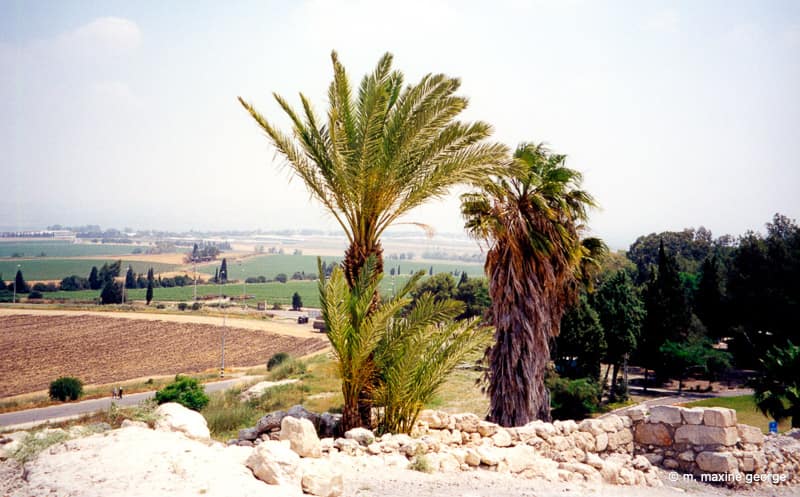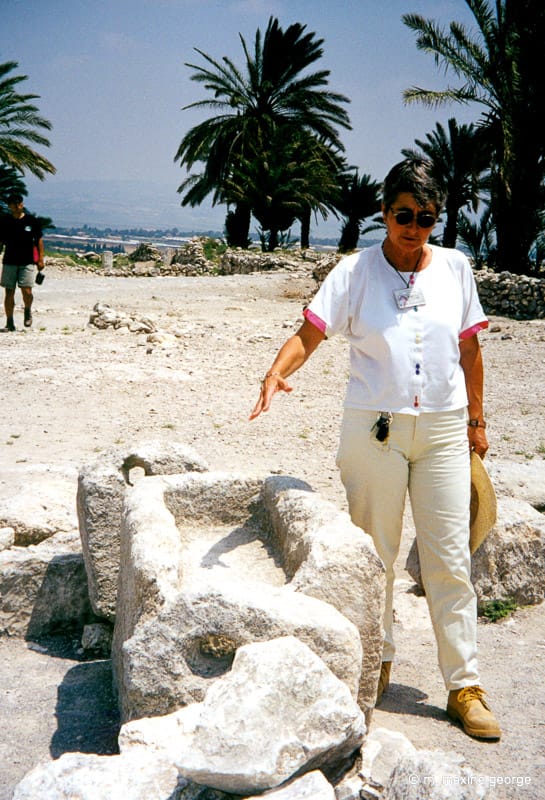Megiddo, Overlooking the Plains of Armageddon
Magic Carpet Journals takes you to Israel’s ancient tell, Megiddo.
Via Magic Carpet Journals. Story and Photos by M. Maxine George.

A visit to Israel can help you understand what the Millennium really means. Our calendar began counting in that land, with the birth of Christ there over two thousand years ago. How does a person get the feeling of the continuum of over two thousand years here in North America, where our visual concept of time began with Columbus’ landing on this continent approximately five hundred years ago? In Megiddo, overlooking the plains of Armageddon, archeologists have uncovered the remains of twenty-five cities, built one on top of the other, over a period of six to eight thousand years, so in Israel two thousand years seems relatively modern! Israel is a progressive new country only seventy years old, but is made up of a people who are proud of the history of their land and are preserving and restoring their ancient heritage.

For the archeology and history buff, Israel is a paradise. Archeological sites are continually being researched and restored. Arrangements can be made through the Israel Tourist Authority to accompany an archeological team for a day out on a dig. Throughout this century the tell*, now recognized as Megiddo, has drawn archeologists, who have been inspired by the Scriptures where Megiddo is mentioned eleven times. This mound of ancient cities has historic connections to Joshua, also King Solomon and was the location of the death of two kings of Judah. The discovery of relics with Egyptian hieroglyphics or figures has helped date some of the layers of the tell, as Egyptian chronology is well documented. Megiddo is mentioned on the walls of the Temple of Amun at Karnak in Egypt. In 1479 BC the Pharaoh Thutmose III conquered Megiddo as part of a campaign to reassert their dominance over the territories in Canaan. (*tell: an ancient mound in the Middle East composed of remains of successive settlements)
For centuries the adjacent Jezreel Valley, also known as Armageddon, was the crossroads where the civilizations of the day met en-route to conduct their trade or wars. The great ancient armies fought their battles there. The dire prediction of the “end of days” forecasts the final battle of civilization, the battle between the forces of light and darkness, will take place on the fields of Armageddon. I could not help but wonder if this serene valley and it’s adjacent tell is not the home of many ancient spirits and legendary heroes, who have been waiting out the millennia, with many secrets yet to reveal to those history buffs and archeologists taking the time to unearth their relics.
King Solomon, known as the Bible’s greatest builder, was administrator of Megiddo. Several structures have been identified with his presence. The sites of two of the palaces built during his reign have been located. An area, believed by some to be the stables of King Solomon was also uncovered. They consist of long rooms, with rows of pillars thought to be where ropes were tied to tether animals. Our guide, Ruth Holzman showed us a feeding trough, hewn out of limestone. This trough would have been called a manger. She postulated it was probably similar to the manger that was used for the newborn baby Jesus.

Another interesting structure is the granary, which would be nearly three thousand years old. Resembling a crater, the walls are embedded with small stones and two flights of steps circle around those walls to the bottom. Holding about 12,800 bushels of grain, the granary functioned as a central supply to feed an expanded population during wars. In days gone by, the city had to be wary of possible invaders.


At one time in its history, the people of Megiddo found a means to protect their water supply, which had become vulnerable to invaders. The height of the mound upon which the city was situated had grown over the centuries. The water supply, a spring, was located outside the city gate, some thirty-five meters below the current height of the tell. Residents had to leave the protection of the city walls to get water. A thirty-five-meter (120 foot) shaft was bored into the rock near the inside of the wall. Steps were built down to the bottom of the shaft and a tunnel was constructed that traveled a distance of 215 feet to the spring outside the city. The original external access to the water was then blocked off. At a later time, the gradient was changed to bring the water to the bottom of the shaft. I went down the stairs and through the ancient passage, finding it hard to believe this engineering feat could have been accomplished nearly nine hundred years before this Millennium began.

Megiddo’s sacred precinct has a recently discovered foundation that may be part of the largest Early Bronze Age temple found to date. On top of that, temple after temple was built on the same site. Megiddo’s famous round altar, made of a large, round, flat topped pile of rocks, was probably used for animal sacrifices. The bone of a lion was discovered here along with other animal bones.


Megiddo is an easy site to peruse at your leisure. The Israel Nature and National Parks Protection Authority laid out footpaths and provided signs amongst the ruins explaining the various areas. A museum at the foot of the hill contains model reconstructions of the main buildings. Food services are also available there. For anyone interested in archeology and history, Megiddo has much to offer.
Story and pictures by M. Maxine George
Last Updated January 26, 2021 by Matthew George – Webmaster
For further information about Masada contact:
Israel Government Tourist Office
180 Bloor St., Suite 700, Toronto, Ont. Canada
Telephone: (416) 964-3784
Fax: (416) 964-2420
